This fluffy and eggy Italian Easter Bread, Pane di Pasqua, is slightly sweet and bursting the with flavors of citrus and anise.
 Pane di Pasqua: A Symbolic Italian Easter Bread
Pane di Pasqua: A Symbolic Italian Easter Bread
It is no surprise that bread has incredible significance around many cultures’ Easter tables.
Just as bread for centuries has been the prime source of bodily sustenance for daily life, Christ, whose resurrection Christians celebrate on Easter, is considered “the bread of life,” (John 6:35), in whom believers will find their daily, spiritual sustenance.
This Italian Easter bread is braided with eggs, which also hold incredible Easter significance as signs from nature of new life, just as we are celebrating new life in the risen Christ.
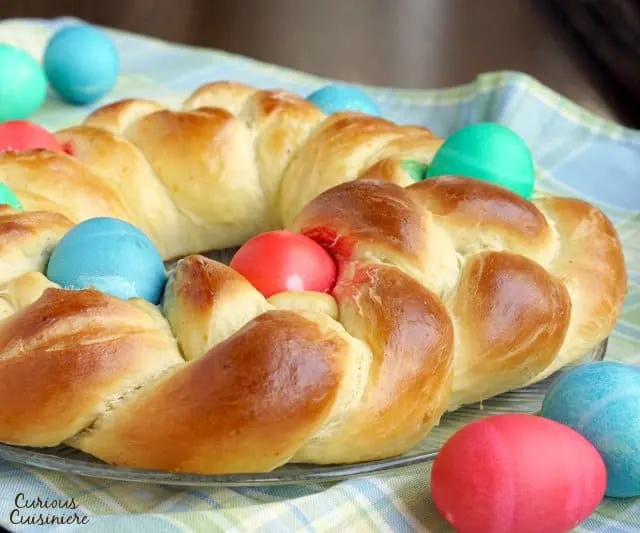
Due to the ending of the fast of Lent, where households would traditionally refrain from rich and sweet dishes, Easter breads are often rich, eggy breads that can range in sweetness, and sometimes are studded with dried fruit, which at one time was a luxury item. (Like this Romanian Easter Bread or Hot Cross Buns).
These are truly celebration breads that each household adapts to their own definition and means of celebrating.
Flavoring Pane di Pasqua
Pane di Pasqua is this oh so fluffy and ever so slightly sweet. This is the perfect background for the light and bright, springy flavors of citrus and anise.
Orange juice and anise are the main flavoring agents in this fluffy bread, and they mingle together quite well, with neither over powering the other as you enjoy each bite.
In order to really brighten the flavor of the bread, we use the zest and juice from the orange.
And, while 1/2 tsp of anise may seem like a lot, particularly if you’re not an anise lover, the flavor really mellows as the bread cooks, leaving just a hint of spice in the finished loaf.
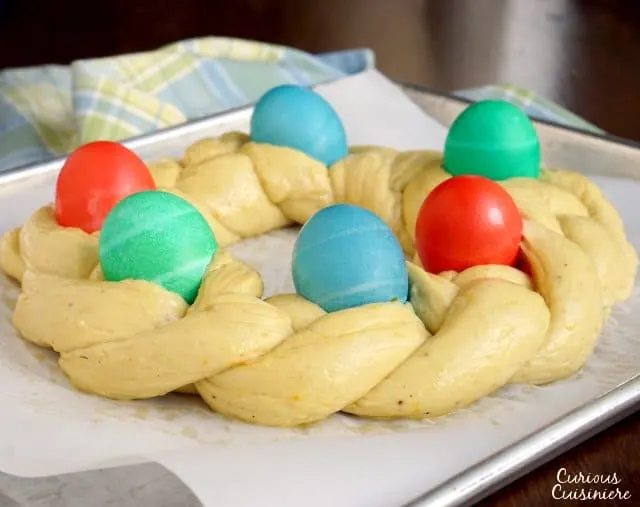
What can I substitute for anise?
We have gotten a lot of questions from people who want to make this Easter bread, but aren’t a fan of the flavor of anise.
If you’re looking for a substitute for anise in this bread, let us first say that the anise flavor in the finished bread is quite subtle. It is more of a light spice flavor than a quintessential anise/licorice flavor. So if you’re on the fence, go ahead and give it a try.
That being said, if anise really isn’t your thing (or you don’t have it on hand), you can definitely leave it out of the bread and it will be just fine.
Other substitutions could be adding some cinnamon or nutmeg in the amount of ground anise we call for in the recipe (1/2 tsp). Still another option would be to replace the anise with 1 tsp of vanilla extract.
Whatever you decide to substitute the anise for, remember that it needs to pair nicely with orange, which is the other prominent flavor in the bread.
How To Make Braided Italian Easter Bread
While this loaf is quite impressive (as is fitting an Easter celebration table) and does contain a number of steps, it it definitely a bread that is worth your time to make.
- Make your dough: The dough for Pane di Pasqua should be soft and slightly tacky, but not sticky. It takes a little kneading by hand to reach a smooth consistency, but you can always use your stand mixer, if you desire.
- Shape your dough: After the first rise, the dough is divided into three sections. Each section is rolled into a rope and the three are braided into a nice long braid that is pinched together into a circle on your baking sheet.
- Add the eggs: Colorful dyed eggs are then tucked into the braid. As the dough rises they settle into place.
- Bake your bread: After the final rise, it’s time to bake the bread! Like magic, the bread puffs up around the eggs and turns a beautiful golden brown.
- Let it cool: While it may be tempting to dive right into the fresh from the oven bread, the hot bread is fragile and it’s best to let it cool for at least 5-10 minutes on the baking sheet before trying to move it.
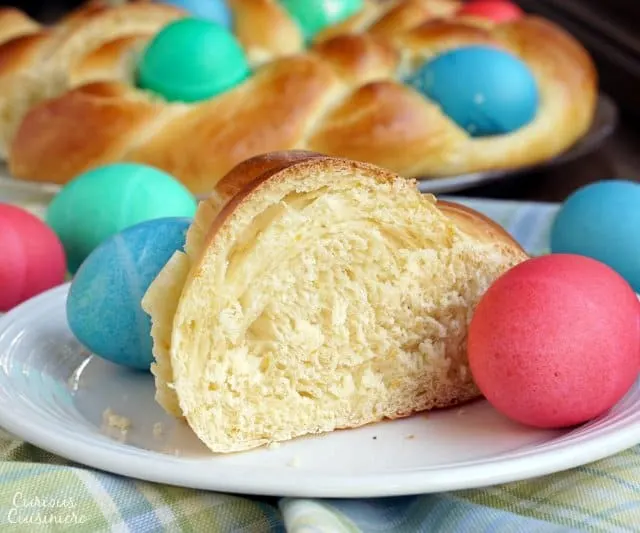
Baking Eggs In The Oven
What makes this bread even more unique is that raw, dyed eggs are braided right into the dough before it is baked.
Don’t worry about those raw eggs though, because the eggs cook as the bread bakes.
So not only do you have an Easter bread, you end up with dyed, hard-cooked eggs too!
Just be very careful as you’re dying your raw eggs. You don’t want to break them before they get cooked!
Maybe that’s not the best task for the little kiddos.
We’ll save the hard boiled eggs for them and let you have fun dying the raw ones!
Our Easy Italian Easter Bread Recipe
The dough for this Italian Easter bread is a very rich dough, containing milk, eggs, and butter.
This makes it very moist and slightly sticky as it comes together. But, after a bit of kneading, it becomes silky smooth and very easy to work with.

After one rise, this fragrant dough gets divided into three pieces and rolled into ropes that will be braided. If you find that the dough springs back on itself as you try to roll it into your 24 inch strand, stop rolling and let the strand rest for 5 minutes (covered with your damp tea towel). This will relax the gluten proteins and make it much easier to continue rolling your strand.
After you shape your bread into a circle and pinch your ends together, it’s time to tuck the eggs into the braided dough.
This part can get a little tricky. Just gently separate the strands of the braid and tuck the egg in.
The most important thing here is to keep the eggs on top of the braid, or even a little towards the center of the circle. If you place them too close to the outer edge of the circle, they tend to roll further outwards as the bread rises.
No matter how the dough chooses to rise around your eggs, the result will be a very impressive loaf.
The beautifully colored eggs and the lovely golden loaf are the perfect recipe for an Easter table centerpiece.
Can I Substitute Fresh Yeast for Active Dry Yeast?
Recently we have been getting a lot of questions about substitutions for the active dry yeast in this bread. While we haven’t tried using fresh yeast in place of the active dry yeast, it should work.
For this recipe you will need 2/3oz (19g) of fresh yeast in place of the 2 1/4 tsp of active dry yeast.
Fresh yeast will not need as long in the hydrating step #1 of the recipe instructions. It also may cause your bread to rise more quickly, so be sure to check it often during proofing.
Can I Substitute Instant Yeast For Active Dry Yeast?
Yes, you should be able to substitute instant yeast for the active dry yeast in this recipe as well. Use the same amount of instant yeast as we call for in active dry yeast.
If using instant yeast, you can skip the hydrating step (step #1) and simply add the yeast to the dry ingredients in step #2. (Don’t forget to add the sugar and the milk to the wet ingredients in step #3.) Then, continue with the instructions as listed.
Note that the dough might rise faster on you, so keep an eye on it as it proofs.
Other Easter Breads
If you love the idea of Easter bread, you’ll want to give Hot Cross Buns and Romanian Easter Bread a try too!
Pane di Pasqua (Italian Easter Bread)

This light and eggy Italian Easter Bread, Pane di Pasqua, bread is slightly sweet and bursting the with the flavors of citrus and anise.
Ingredients
For the Bread
- ½ c (118 ml) milk, warmed to 80-90F
- ¼ c (50 g) sugar
- 2 ¼ tsp (7 g) active dry yeast, (1 packet)
- 4 - 5 c (480-600 g) unbleached all-purpose flour, divided
- 1 tsp salt
- 1 orange, zested and juiced (roughly ½ c (118 ml) juice)
- 2 eggs, lightly beaten
- ¼ c (57 g) unsalted butter, melted and cooled
- ½ tsp ground anise, or pure anise extract
For the Braid
- 6 raw eggs, dyed if desired
- 1 egg, beaten with 1 tsp water
Instructions
Making The Dough
- In a small bowl, mix the warm milk with the sugar, until dissolved. Add the yeast and set the mixture aside until it begins to foam slightly, 5-10 min.
- While the yeast is hydrating, in a large bowl, mix together 3 c all-purpose flour and the salt. Set aside.
- In a medium bowl, whisk together the orange juice and zest, the beaten eggs, melted butter, and anise. Set aside.
- Add the yeast mixture and orange juice mixture to the flour, stirring until moistened. Add the remaining flour to the dough, a little at a time, mixing until the dough comes together.
- Turn the dough out onto a lightly floured surface and knead for 5-10 minutes, until soft and smooth.
- Place the dough in a clean, oiled bowl, turning to coat the dough with oil. Cover the dough with plastic wrap or a damp tea towel, and set in a warm (70-75F), draft-free place to rise until puffy and doubled, 1-2 hours.*
Shaping the Ring
- Once the dough has doubled turn it out onto a lightly floured surface.
- Divide the dough into 3 equal pieces and gently roll each into an 24” rope. (If the dough springs back on you, cover the ropes with a damp towel and let rest for 5-10 minutes to relax the gluten. Then try rolling them out again.)
- Pinch one end of all three ropes together and braid the strands loosely. Shape the braid into a ring on a parchment-lined baking sheet.
- Gently tuck the dyed, raw eggs into the braid. (Be sure to place them on top, or slightly closer to the center of the ring, as opposed to near the outer edge, as the eggs tend to roll to the outer edge of the ring during the final rising time.)
- Gently brush the ring with the beaten egg and water egg wash, being careful around the dyed eggs (the moisture from the egg wash tends to make the dye run).
- Let the ring rise until puffy and nearly doubled, 45 minutes - 1 hour.*
Baking The Bread
- Near the end of your rising time, preheat the oven to 350F.
- Bake the bread for 25 minutes, until the ring is golden and sounds hollow when tapped gently.
- Let the bread cool on the baking sheet for at least 10 minutes before transferring to a wire rack to cool completely.
Notes
*Since this is a rich dough, rise time may be longer depending on your kitchen and your dough. If it doesn't get puffy and nearly double in the time listed, just give it some patience and more time.
This recipe from 2014 was updated March 2018. We made the bread dough even easier to work with. Enjoy!
Nutrition Information:
Yield:
12Serving Size:
12 peopleAmount Per Serving: Calories: 155Saturated Fat: 1.1gCholesterol: 44mgSodium: 222mgCarbohydrates: 28gFiber: 1.9gSugar: 6.4gProtein: 5.3g
This is one of the recipes from the early days of Curious Cuisiniere. We’ve updated our pictures since we first shared it, but we’ve left some originals here, in case you’ve found us in the past and are looking for that old, familiar image.
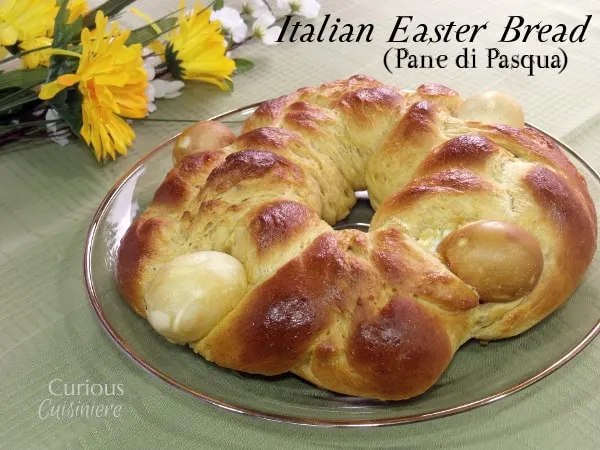
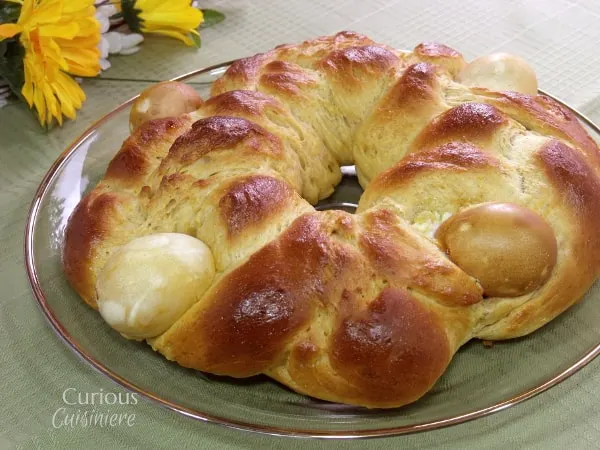
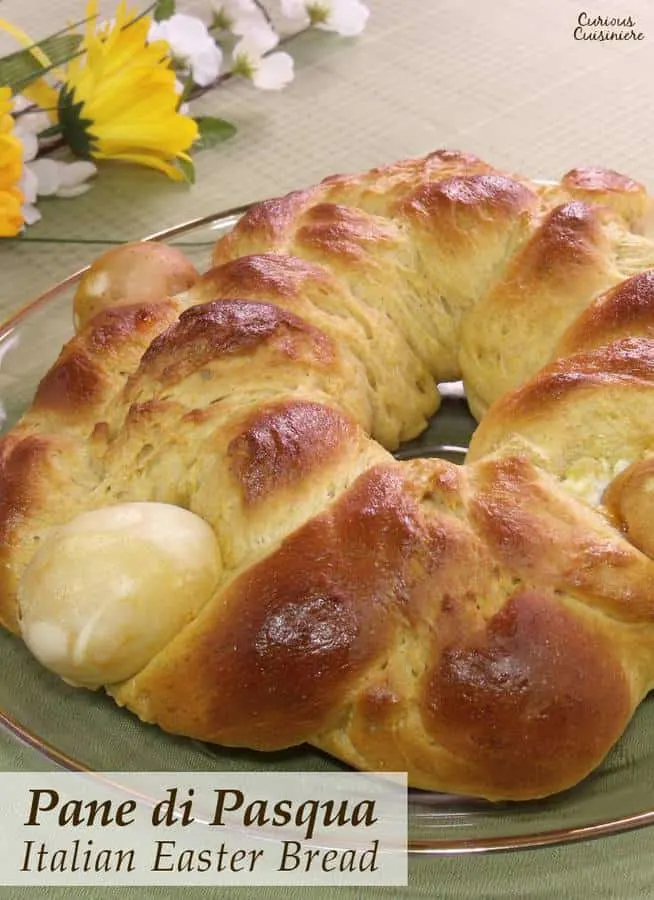
If you liked this recipe, here are some similar dishes you may enjoy!

Sarah is one of Curious Cuisiniere’s founding duo. Her love for cultural cuisines was instilled early by her French Canadian Grandmother. Her experience in the kitchen and in recipe development comes from years working in professional kitchens. She has traveled extensively and enjoys bringing the flavors of her travels back to create easy-to-make recipes.
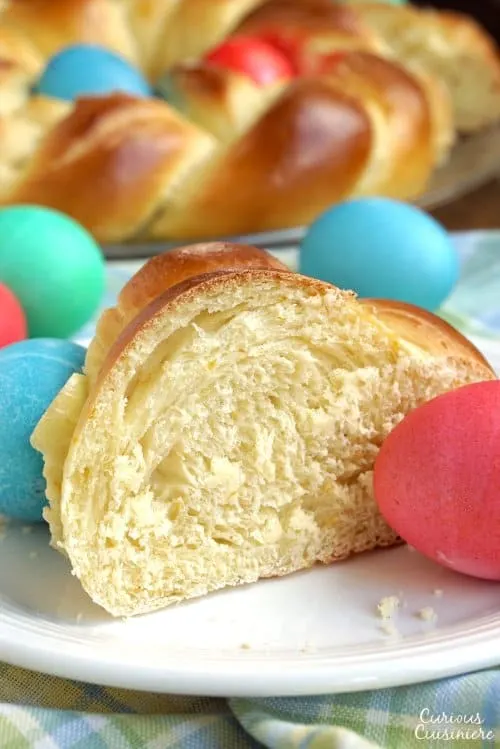 Pane di Pasqua: A Symbolic Italian Easter Bread
Pane di Pasqua: A Symbolic Italian Easter Bread



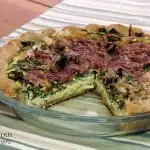
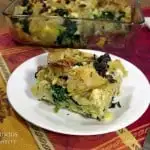


Maria
Monday 1st of April 2024
This Easter bread was delicious. I have now made it multiple times and the recipe is foolproof. I added cranberries to mine as I was kneading the dough. So moist and flavourful. Great to use for French toast or plain with a cup of coffee. This recipe is a keeper! Thanks for sharing.
Sarah - Curious Cuisiniere
Thursday 18th of April 2024
Thank you Maria! Cranberries sound like a very nice addition!
JR
Tuesday 26th of March 2024
1/4 cup of warm milk with 1/4 cup of sugar to add the yeast into? I'm really confused by this. First off, milk already has sugar in it (if its being used for yeast proofing), and secondly - a quarter of a cup of sugar to proof the yeast? Doesn't make sense to me.
Sarah - Curious Cuisiniere
Tuesday 26th of March 2024
The ingredients list 1/2 cup of warm milk (not 1/4c). If you don't want your bread quite as sweet, you can always decrease the sugar.
Lisa Paliotta
Thursday 7th of September 2023
Hi, For as long as I can remember my Mom has made Italian Easter Bread every year (or at least this is what I was told it was and believed all this time). And now I do as well. We use a similar recipe without the orange zest and orange juice and we add anise seeds instead of anise powder or extract. I believe it is a double recipe but I been making it so long that I am not sure. 1 & 1/2 cup milk Luke warm;1/2 cup warm water, 2 packets dry yeast & 1 tbsp sugar(combine and let get foamy); 1/2 cup sugar; 2 tsp salt; 2 beaten eggs; 1/2 cup butter; 7 to 7 & 1/2 cup flour and 1 tsp Anise seeds. Add all wet ingredients, then and in sugar till dissolved, then slowly add the flour stirred with salt & anise seed. Let flour be absorbed until dough is not sticky and forms a dough ball. Let rise 1 & 1/2 hrs or until doubled. Punch down,kneed again, shape into Braid loaves and let rise 35 to 45 mins. Prior to placing in oven at 350 degrees Brush with egg wash and sprinkle heavily with multi colored non pariels. When I was a child and while my daughter was young we colored eggs and nested them in the braid. I have heard of this tradition in other places among other Italians (many without anise flavoring) but your recipe is the closest to my Mom's. She's in her 80's and does not remember where she got the recipe or why she puts anise in it. Her mother is from Calabria and never made the bread. If anyone can help with this mystery, I would appreciate it. I love that I am not the only fan of anise. We give loaves to neighbors and our relatives who love the bread. It does not taste or smell like licorice in the bread. In fact it does not taste right without it. I forgot it one year and every one asked what I did differently because they missed the ingredient but couldnt identify what it was.This Easter I will add the orange zest and juice. I think it may improve the recipe. Thank you for posting your recipe.
Donna Pranzarone
Sunday 31st of March 2024
@Lisa Paliotta, Hi Lisa My family is from Calabria, we always use anise oil and some seed, but anise extract is good too. The anise oil is very concentrated so you’ll need to use a conversion chart ( online) , anise extract to oil, It gives such a wonderful favor! Sometimes I make the same bread and use lemon and vanilla instead, and top it with a thick glaze. It’s so delicious. I’ve never tried this recipe but it sounds very good. We all use different favors depending on what we’re brought up with or what flavors we like. Have a Blessed Easter!
Sarah - Curious Cuisiniere
Tuesday 12th of September 2023
Thank you for sharing Lisa. I suspect there are regional variations, and that is where the anise comes from.
Joanne Mary P
Sunday 23rd of April 2023
What is nice about this recipe is you can make it your own. I made the bread for Easter and also made it again today for another family Easter dinner. The first time I made one big circle with three 24” ropes and followed the recipe exactly. Today I made 6 ropes and made two braided 12” loaves, but used both lemon and orange zest. I want to put slivered almonds on top the next time I make it because my mom made her bread that way. Unfortunately, we can’t find her recipe, but my sister said this recipe tastes like Mom’s.
Sarah - Curious Cuisiniere
Saturday 29th of April 2023
Thanks for sharing how you made this bread your own Joanne! We're so glad our recipe brings back family memories!
Mike
Sunday 9th of April 2023
Pretty close to what my grandma made every easter. She was born in Abruzzo, 1896. Only difference, she put white raisins in the dough.
Sarah - Curious Cuisiniere
Tuesday 11th of April 2023
That sounds tasty! We're glad you enjoyed the bread!